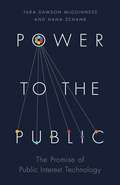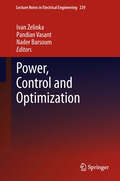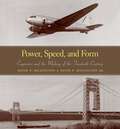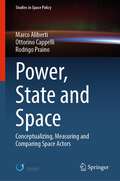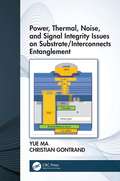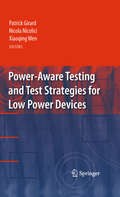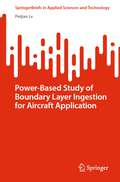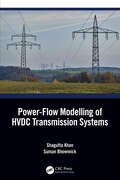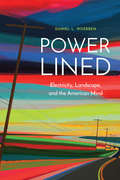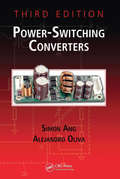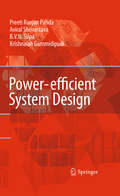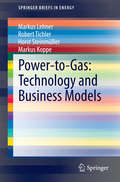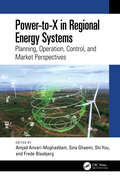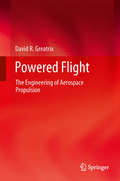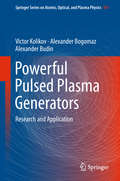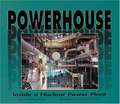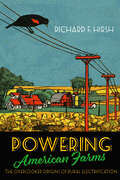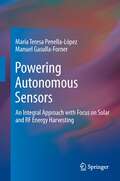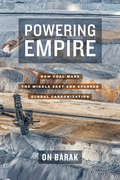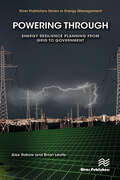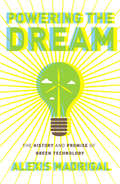- Table View
- List View
Power over Peoples
by Daniel R. HeadrickFor six hundred years, the nations of Europe and North America have periodically attempted to coerce, invade, or conquer other societies. They have relied on their superior technology to do so, yet these technologies have not always guaranteed success. Power over Peoples examines Western imperialism's complex relationship with technology, from the first Portuguese ships that ventured down the coast of Africa in the 1430s to America's conflicts in the Middle East today. Why did the sailing vessels that gave the Portuguese a century-long advantage in the Indian Ocean fail to overcome Muslim galleys in the Red Sea? Why were the same weapons and methods that the Spanish used to conquer Mexico and Peru ineffective in Chile and Africa? Why didn't America's overwhelming air power assure success in Iraq and Afghanistan? In Power over Peoples, Daniel Headrick traces the evolution of Western technologies--from muskets and galleons to jet planes and smart bombs--and sheds light on the environmental and social factors that have brought victory in some cases and unforeseen defeat in others. He shows how superior technology translates into greater power over nature and sometimes even other peoples, yet how technological superiority is no guarantee of success in imperialist ventures--because the technology only delivers results in a specific environment, or because the society being attacked responds in unexpected ways. Breathtaking in scope, Power over Peoples is a revealing history of technological innovation, its promise and limitations, and its central role in the rise and fall of empire.
Power to the Public: The Promise of Public Interest Technology
by Hana Schank Tara Dawson McGuinnessA powerful new blueprint for how governments and nonprofits can harness the power of digital technology to help solve the most serious problems of the twenty-first centuryAs the speed and complexity of the world increases, governments and nonprofit organizations need new ways to effectively tackle the critical challenges of our time—from pandemics and global warming to social media warfare. In Power to the Public, Tara Dawson McGuinness and Hana Schank describe a revolutionary new approach—public interest technology—that has the potential to transform the way governments and nonprofits around the world solve problems. Through inspiring stories about successful projects ranging from a texting service for teenagers in crisis to a streamlined foster care system, the authors show how public interest technology can make the delivery of services to the public more effective and efficient.At its heart, public interest technology means putting users at the center of the policymaking process, using data and metrics in a smart way, and running small experiments and pilot programs before scaling up. And while this approach may well involve the innovative use of digital technology, technology alone is no panacea—and some of the best solutions may even be decidedly low-tech.Clear-eyed yet profoundly optimistic, Power to the Public presents a powerful blueprint for how government and nonprofits can help solve society’s most serious problems.
Power, Control and Optimization
by Nader Barsoum Pandian Vasant Ivan ZelinkaThe book consists of chapters based on selected papers of international conference "Power, Control and Optimization 2012", held in Las Vegas, USA. Readers can find interesting chapters discussing various topics from the field of power control, its distribution and related fields. Book discusses topics like energy consumption impacted by climate, mathematical modeling of the influence of thermal power plant on the aquatic environment, investigation of cost reduction in residential electricity bill using electric vehicle at peak times or allocation and size evaluation of distributed generation using ANN model and others. Chapter authors are to the best of our knowledge the originators or closely related to the originators of presented ideas and its applications. Hence, this book certainly is one of the few books discussing the benefit from intersection of those modern and fruitful scientific fields of research with very tight and deep impact on real life and industry. This book is devoted to the studies of common and related subjects in intensive research fields of power technologies. For these reasons, we believe that this book will be useful for scientists and engineers working in the above-mentioned fields of research and applications.
Power, Speed, and Form: Engineers and the Making of the Twentieth Century
by David P. Billington David Billington Jr.Power, Speed, and Form is the first accessible account of the engineering behind eight breakthrough innovations that transformed American life from 1876 to 1939—the telephone, electric power, oil refining, the automobile, the airplane, radio, the long-span steel bridge, and building with reinforced concrete. Beginning with Thomas Edison's system to generate and distribute electric power, the authors explain the Bell telephone, the oil refining processes of William Burton and Eugene Houdry, Henry Ford's Model T car and the response by General Motors, the Wright brothers' airplane, radio innovations from Marconi to Armstrong, Othmar Ammann's George Washington Bridge, the reinforced concrete structures of John Eastwood and Anton Tedesko, and in the 1930s, the Chrysler Airflow car and the Douglas DC-3 airplane.These innovations used simple numerical ideas, which the Billingtons integrate with short narrative accounts of each breakthrough—a unique and effective way to introduce engineering and how engineers think. The book shows how the best engineering exemplifies efficiency, economy and, where possible, elegance. With Power, Speed, and Form, educators, first-year engineering students, liberal arts students, and general readers now have, for the first time in one volume, an accessible and readable history of engineering achievements that were vital to America's development and that are still the foundations of modern life.
Power, State and Space: Conceptualizing, Measuring and Comparing Space Actors (Studies in Space Policy #35)
by Marco Aliberti Ottorino Cappelli Rodrigo PrainoThis book explains on what basis a nation can claim the status of space power, what are the criteria differentiating a space power from “lesser” space actors, and how their spacepower can be empirically measured and assessed. To this end, it sets forth a comprehensive multidisciplinary framework to enable a dynamic comparison of space actors and of the pathways that lead them in and out of the space powers’ club. Drawing upon a critical review of the existing literature, it conceptualises spacepower as a form of state power based on the complex interplay between the two defining dimensions of stateness, namely the well-studied dimension of capacity and the often neglected yet exceedingly important dimension of autonomy. The book demonstrates that only actors possessing high levels of both autonomy and capacity qualify as space powers. Different levels of either capacity or autonomy produce other types of space actors, including skilled spacefarers, self-reliant spacefarers, primed spacefarers, and emerging space actors. This innovative conceptual framework is complemented by an in-depth comparative assessment that collects and processes a large amount of hard-to-find data on the most active global space actors and aggregates multiple indicators into a compound, non-hierarchical index of space power visualised in the form of a matrix.
Power, Thermal, Noise, and Signal Integrity Issues on Substrate/Interconnects Entanglement
by Yue Ma Christian GontrandAs demand for on-chip functionalities and requirements for low power operation continue to increase as a result of the emergence in mobile, wearable and internet-of-things (IoT) products, 3D/2.5D have been identified as an inevitable path moving forward. As circuits become more and more complex, especially three-dimensional ones, new insights have to be developed in many domains, including electrical, thermal, noise, interconnects, and parasites. It is the entanglement of such domains that begins the very key challenge as we enter in 3D nano-electronics. This book aims to develop this new paradigm, going to a synthesis beginning between many technical aspects.
Power-Aware Testing and Test Strategies for Low Power Devices
by Xiaoqing Wen Nicola Nicolici Patrick GirardManaging the power consumption of circuits and systems is now considered one of the most important challenges for the semiconductor industry. Elaborate power management strategies, such as dynamic voltage scaling, clock gating or power gating techniques, are used today to control the power dissipation during functional operation. The usage of these strategies has various implications on manufacturing test, and power-aware test is therefore increasingly becoming a major consideration during design-for-test and test preparation for low power devices. This book explores existing solutions for power-aware test and design-for-test of conventional circuits and systems, and surveys test strategies and EDA solutions for testing low power devices.
Power-Based Study of Boundary Layer Ingestion for Aircraft Application (SpringerBriefs in Applied Sciences and Technology)
by Peijian LvThis book presents research on Boundary Layer Ingestion (BLI). BLI is an aircraft-engine integration technique that aims at integrating the aircraft and the propulsion system such that the overall aircraft fuel consumption can be reduced. In this research, theoretical analysis suggests that the minimization of total power consumption should be used as a design criterion for aircraft utilizing BLI rather than focusing on the minimization of drag. Numerical simulations are performed, and the simulation results are processed using the PBM to support the theoretical analysis. Furthermore, an experimental study is carried out with a focus on the power conversion processes involved for a propulsor operating in the wake. Stereoscopic PIV is employed in order to visualize the flow and understand the physics. The so-called Power-based Method is used to quantify the power conversion mechanisms. The results prove that the dominant mechanism responsible for the efficiency enhancement is due to the utilization of body wake energy by the wake ingesting propeller. In short, the importance of wake energy flow rate in understanding the BLI phenomenon is highlighted. This book will be useful for researchers in the field of aircraft propulsion, aircraft aerodynamics, and airframe propulsion integration.
Power-Flow Modelling of HVDC Transmission Systems
by Suman Bhowmick Shagufta KhanThis book deals exclusively with the power-flow modelling of HVDC transmission systems. Different types of HVDC transmission systems, their configurations/connections and control techniques are covered in detail. Power-Flow modelling of both LCC- and VSC-based HVDC systems is covered in this book. Both the unified and the sequential power-flow methods are addressed. DC grid power-flow controllers and renewable energy resources like offshore wind farms (OWFs) are also incorporated into the power-flow models of VSC-HVDC systems. The effects of the different power-flow methods and HVDC control strategies on the power-flow convergence are detailed along with their implementation. Features: Introduces the power-flow concept and develops the power-flow models of integrated AC/DC systems. Different types of converter control are modelled into the integrated AC/DC power-flow models developed. Both unified and the sequential power-flow methods are addressed. DC grid power-flow controllers like the IDCPFC and renewable energy resources like offshore wind farms (OWFs) are introduced and subsequently modelled into the power-flow algorithms. Integrated AC/DC power-flow models developed are validated by implementation in the IEEE 300-bus and European 1354-bus test networks incorporating different HVDC grids. This book aims at researchers and graduate students in Electrical Engineering, Power Systems, and HVDC Transmission.
Power-Lined: Electricity, Landscape, and the American Mind
by Daniel L. WuebbenThe proliferation of electric communication and power networks have drawn wires through American landscapes like vines through untended gardens since 1844. But these wire networks are more than merely the tools and infrastructure required to send electric messages and power between distinct places; the iconic lines themselves send powerful messages. The wiry webs above our heads and the towers rhythmically striding along the horizon symbolize the ambiguous effects of widespread industrialization and the shifting values of electricity and landscape in the American mind. In Power-Lined Daniel L. Wuebben weaves together personal narrative, historical research, cultural analysis, and social science to provide a sweeping investigation of the varied influence of overhead wires on the American landscape and the American mind. Wuebben shows that overhead wires—from Morse’s telegraph to our high-voltage grid—not only carry electricity between American places but also create electrified spaces that signify and complicate notions of technology, nature, progress, and, most recently, renewable energy infrastructure. Power-Lined exposes the subtle influences wrought by the wiring of the nation and shows that, even in this age of wireless devices, perceptions of overhead lines may be key in progressing toward a more sustainable energy future.
Power-Switching Converters
by Simon Ang Alejandro Oliva Gary Griffiths Richard HarrisonSignificantly expanded and updated with extensive revisions, new material, and a new chapter on emerging applications of switching converters, Power-Switching Converters, Third Edition offers the same trusted, accessible, and comprehensive information as its bestselling predecessors. Similar to the two previous editions, this book can be used for a
Power-efficient System Design
by Preeti Ranjan Panda Krishnaiah Gummidipudi B. V. Silpa Aviral ShrivastavaThis book addresses power optimization in modern electronic and computer systems. Several forces aligned in the past decade to drive contemporary computing in the direction of low power and energy-awareness: the mobile revolution took the world by storm; power budgets forced mainstream processor designers to abandon the quest for higher clock frequency; and large data centers with overwhelming power costs began to play vital roles in our daily lives. Power optimization was elevated to a first class design concern, forcing everyone from the process engineer, circuit designer, processor architect, software developer, system builder, and even data center maintainer to make conscious efforts to reduce power consumption using myriad techniques and tools. This book explores power optimization opportunities and their exploitation at various levels of abstraction. Fundamental power optimizations are covered at each level of abstraction, concluding in a case study illustrating the application of the major techniques to a graphics processor. This book covers a comprehensive range of disparate power optimizations and is designed to be accessible to students, researchers, and practitioners alike.
Power-to-Gas: Technology and Business Models
by Markus Lehner Robert Tichler Horst Steinmüller Markus KoppeIncreased production of energy from renewable sources leads to a need for both new and enhanced capacities for energy transmission and intermediate storage. The book first compares different available storage options and then introduces the power-to-gas concept in a comprehensive overview of the technology. The state of the art, advancements, and future requirements for both water electrolysis and methanation are described. The integration of renewable hydrogen and methane into the gas grid is discussed in terms of the necessary technological measures to be taken. Because the power-to-gas system is very flexible, providing numerous specific applications for different targets within the energy sector, possible business models are presented on the basis of various process chains taking into account different plant scales and operating scenarios. The influence of the scale and the type of the integration of the technology into the existing energy network is highlighted with an emphasis on economic consequences. Finally, legal aspects of the operation and integration of the power-to-gas system are discussed.
Power-to-X in Regional Energy Systems: Planning, Operation, Control, and Market Perspectives
by Frede Blaabjerg Amjad Anvari-Moghaddam Shi You Sina GhaemiPower-to-X in Regional Energy Systems discusses the role of these technologies in achieving a carbon-neutral economy and the impact on the energy markets, with implications for electricity, gas, hydrogen, and ancillary services. It focuses on the challenges and benefits of implementing PtX technologies in regional-scale applications.Emphasizing the role of PtX technologies as enablers of sector coupling, the book provides a comprehensive understanding of how these technologies integrate and interact with the industry, transportation, and residential sectors. It describes the significance of PtX, optimal planning, and cost-effective operation of PtX technologies across different sectors and the impact of PtX devices on energy markets. The book considers investing in PtX technologies and contributing to the transition to a sustainable economy.The book will interest professionals and policymakers working in various energy sectors. Researchers and academics in electrical engineering, power systems, renewable energy, and energy economics will also find the content useful.
Powered Flight
by David R. GreatrixWhilst most contemporary books in the aerospace propulsion field are dedicated primarily to gas turbine engines, there is often little or no coverage of other propulsion systems and devices such as propeller and helicopter rotors or detailed attention to rocket engines. By taking a wider viewpoint, Powered Flight - The Engineering of Aerospace Propulsion aims to provide a broader context, allowing observations and comparisons to be made across systems that are overlooked by focusing on a single aspect alone. The physics and history of aerospace propulsion are built on step-by-step, coupled with the development of an appreciation for the mathematics involved in the science and engineering of propulsion. Combining the author's experience as a researcher, an industry professional and a lecturer in graduate and undergraduate aerospace engineering, Powered Flight - The Engineering of Aerospace Propulsion covers its subject matter both theoretically and with an awareness of the practicalities of the industry. To ensure that the content is clear, representative but also interesting the text is complimented by a range of relevant graphs and photographs including representative engineering, in addition to several propeller performance charts. These items provide excellent reference and support materials for graduate and undergraduate projects and exercises. Students in the field of aerospace engineering will find that Powered Flight - The Engineering of Aerospace Propulsion supports their studies from the introductory stage and throughout more intensive follow-on studies.
Powerfuels: Status and Prospects (Green Energy and Technology)
by Martin Kaltschmitt Ulf Neuling Nils BullerdiekPowerfuels are the subject of intense and often contentious current discussions within industry, research, politics, as well as the overall society. These discussions primarily revolve around the practical and technical feasibility of power-to-X processes and applications, their economic viability, the respective environmental benefits, the contribution to climate protection as well as the social acceptability. Thus, the primary aim of this book is to provide a comprehensive overview of various aspects, diverse considerations, and different perspectives regarding the future role and utilization of power-to-X pathways on a global scale. This encompasses the challenge of sourcing necessary educts / feedstock options, their conversion into different products and product groups, exploring the possibilities of using these electricity-based fuels / hydrocarbons in various markets, and establishing suitable framework conditions for viable and sustainable markets in the years to come. These objectives are achieved through a collection of papers contributed by experts actively engaged in various fields related to power-to-X.
Powerful Pulsed Plasma Generators: Research and Application (Springer Series on Atomic, Optical, and Plasma Physics #101)
by Victor Kolikov Alexander Bogomaz Alexander BudinThis book presents experimental and theoretical results on extremely powerful plasma generators. It addresses pulsed electrical mega-ampere arcs and the mechanisms of energy transfer from the arc into hydrogen, helium and air under pressures up to 250 MPa and currents up to 2 MA. Extreme plasma parameters and increased energy density in the arc were achieved. It was found experimentally that increasing the initial gas pressure to hundreds of MPa leads to improved arc stability, high efficiency of energy transfer from arc to gas, and plasma enthalpy growth. The data obtained data provides the basis for the development of electrophysical devices with high energy density, e.g. high intensity sources for visible, UV and X-ray irradiation for laser pumping, generators of high enthalpy plasma jets, and plasma chemical reactors.
Powerhouse: Inside a Nuclear Power Plant
by Charlotte WilcoxYou use electricity every day at home and at school, but do you know where it comes from? About twenty percent of our electricity comes from nuclear energy-energy released when the nucleus of an atom splits apart. To find out how power from tiny atoms of uranium turns into the power behind your light switch, step inside a nuclear power plant. In Powerhouse, author Charlotte Wilcox follows the process of creating electricity from nuclear fuel at Prairie Island, a nuclear power plant in Minnesota. Along the way, readers will learn about atoms, radiation, the problem of nuclear waste, and the future of nuclear power. Jerry Boucher's full-color photographs give a behind-the-scenes look at this important and controversial energy source.
Powering American Farms: The Overlooked Origins of Rural Electrification
by Richard F. HirshThe untold story of the power industry's efforts to electrify growing numbers of farms in the years before the creation of Depression-era government programs.Even after decades of retelling, the story of rural electrification in the United States remains dramatic and affecting. As textbooks and popular histories inform us, farmers obtained electric service only because a compassionate federal government established the Tennessee Valley Authority and the Rural Electrification Administration (REA) during the Great Depression of the 1930s. The agencies' success in raising the standard of living for millions of Americans contrasted with the failure of the greedy big-city utility companies, which showed little interest in the apparently unprofitable nonurban market. Traditional accounts often describe the nation's population as split in two, separated by access to a magical form of energy: just past cities' limits, a bleak, preindustrial class of citizens endured, literally in near darkness at night and envious of their urban cousins, who enjoyed electrically operated lights, refrigerators, radios, and labor-saving appliances.In Powering American Farms, Richard F. Hirsh challenges the notion that electric utilities neglected rural customers in the years before government intervention. Drawing on previously unexamined resources, Hirsh demonstrates that power firms quadrupled the number of farms obtaining electricity in the years between 1923 and 1933, for example. Though not all corporate managers thought much of the farm business, a cadre of rural electrification advocates established the knowledge base and social infrastructure upon which New Deal organizations later capitalized. The book also suggests that the conventional storyline of rural electrification remains popular because it contains a colorful hero, President Franklin D. Roosevelt, and villainous utility magnates, such as Samuel Insull, who make for an engaging—but distorted—narrative.Hirsh describes the evolution of power company managers' thinking in the 1920s and early 1930s—from believing that rural electrification made no economic sense to realizing that serving farmers could mitigate industry-wide problems. This transformation occurred as agricultural engineers in land-grant universities, supported by utilities, demonstrated productive electrical technologies that yielded healthy profits to farmers and companies alike. Gaining confidence in the value of rural electrification, private firms strung wires to more farms than did the REA until 1950, a fact conveniently omitted in conventional accounts. Powering American Farms will interest academic and lay readers of New Deal history, the history of technology, and revisionist historiography.
Powering Autonomous Sensors
by María Teresa Penella-López Manuel Gasulla-FornerAutonomous sensors transmit data and power their electronics without using cables. They can be found in e.g. wireless sensor networks (WSNs) or remote acquisition systems. Although primary batteries provide a simple design for powering autonomous sensors, they present several limitations such as limited capacity and power density, and difficulty in predicting their condition and state of charge. An alternative is to extract energy from the ambient (energy harvesting). However, the reduced dimensions of most autonomous sensors lead to a low level of available power from the energy transducer. Thus, efficient methods and circuits to manage and gather the energy are a must. An integral approach for powering autonomous sensors by considering both primary batteries and energy harvesters is presented. Two rather different forms of energy harvesting are also dealt with: optical (or solar) and radiofrequency (RF). Optical energy provides high energy density, especially outdoors, whereas RF remote powering is possibly the most feasible option for autonomous sensors embedded into the soil or within structures. Throughout different chapters, devices such as primary and secondary batteries, supercapacitors, and energy transducers are extensively reviewed. Then, circuits and methods found in the literature used to efficiently extract and gather the energy are presented. Finally, new proposals based on the authors' own research are analyzed and tested. Every chapter is written to be rather independent, with each incorporating the relevant literature references. Powering Autonomous Sensors is intended for a wide audience working on or interested in the powering of autonomous sensors. Researchers and engineers can find a broad introduction to basic topics in this interesting and emerging area as well as further insights on the topics of solar and RF harvesting and of circuits and methods to maximize the power extracted from energy transducers.
Powering Empire: How Coal Made the Middle East and Sparked Global Carbonization
by On BarakThe Age of Empire was driven by coal, and the Middle East—as an idea—was made by coal. Coal’s imperial infrastructure presaged the geopolitics of oil that wreaks carnage today, as carbonization threatens our very climate. Powering Empire argues that we cannot promote worldwide decarbonization without first understanding the history of the globalization of carbon energy. How did this black rock come to have such long-lasting power over the world economy? Focusing on the flow of British carbon energy to the Middle East, On Barak excavates the historic nexus between coal and empire to reveal the political and military motives behind what is conventionally seen as a technological innovation. He provocatively recounts the carbon-intensive entanglements of Western and non-Western powers and reveals unfamiliar resources—such as Islamic risk-aversion and Gandhian vegetarianism—for a climate justice that relies on more diverse and ethical solutions worldwide.
Powering Future: Clean Energy Solutions for a Sustainable Planet (Clean Energy Production Technologies)
by Akhilesh Kumar YadavThis edited volume explores the world of clean energy, diving into technological innovations and advancements. This book discusses the complexities of our energy landscape, providing comprehensive insights into renewable technologies and their environmental impacts. The need for renewable energy stems from various environmental, economic, and social concerns. The renewable energy sources such as solar, wind, hydro, and geothermal power offer sustainable alternatives to finite fossil fuels. They reduce greenhouse gas emissions, mitigate climate change, enhance energy security by diversifying the energy mix, and diminish dependence on imported fuels, thus decreasing geopolitical risks. Transitioning to clean energy production technologies also reduces air and water pollution, which is crucial for a sustainable future, ensuring environmental protection, economic prosperity, and social equity for present and future generations. Some of the key topics covered are solar energy utilization; efficiency and life cycle analysis of solar panels; nature-based energy generation; sustainability through biomass and biogas; nuclear energy; geothermal energy, among others. This book is an engaging read for students, academics, researchers, policymakers, and climate enthusiasts, offering valuable information to assist us in making informed decisions for a cleaner, greener future.
Powering Planet Earth: Energy Solutions for the Future
by Vincenzo Balzani Nicola ArmaroliIn their book Nicola Armaroli, Vincenzo Balzani and Nick Serpone uncover the background details associated with a transition to sustainable energy production that are routinely swept under the table in public discussions. They are not only concerned with the (alleged) advantages and disadvantages of any one energy generation technology from a technical viewpoint, but also with the ecological, economic, political and social consequences of an inevitable transition. In a highly readable manner aimed at an international audience, the authors introduce the often misused and sometimes abused term 'energy' and give a lucid account of the development of energy production from timber to nuclear energy and renewable energies. They compare various energy generation methods with respect to their efficiency and practicability for large-scale implementation and examine if, and how, these methods live up to the expectations and promises their proponents make. In addition, the authors juxtapose the political and economic prerequisites in different regions of the world that advance, or hinder, an energy turnaround. They round off their book by debunking the seventeen most popular myths often cited in discussions on energy issues. As a result, the authors provide ammunition for debate, underpin (and unsettle) opinions using facts, and challenge comfortable and popular chains of reasoning.
Powering Through: Energy Resilience Planning from Grid to Government
by Brian Levite Alex RakowThe threats to the electricity grid are on the rise at the same time as society is increasing its dependence on electricity for every aspect of our personal, social, and economic lives. We are accelerating that dependence – looking to the electrification of transportation and buildings as a way to stem the threats of climate change. Those threats have now arrived (in the form of more extreme weather, droughts, and wildfire) and they are joined by increasing threats from an aging grid and cyberattacks. The grid we rely on is experiencing increasingly vulnerable external forces. We aren’t helpless. Effective planning around these threats can dramatically reduce the havoc they engender on the electric grid. At every level, from a single building, to a city, to the electric grid and the federal government, steps can be taken to improve our resilience to threats to the electricity system. When those efforts are coordinated, their benefits multiply. This book aims to provide every level of decision-maker with tools and best practices for reducing the risk of and from electricity loss. It is written in non-technical language, with a focus on actionable, easily implemented steps.
Powering the Dream: The History and Promise of Green Technology
by Alexis MadrigalFew today realize that electric cabs dominated Manhattan's streets in the 1890s; that Boise, Idaho, had a geothermal heating system in 1910; or that the first megawatt turbine in the world was built in 1941 by the son of publishing magnate G. P. Putnam--a feat that would not be duplicated for another forty years. Likewise, while many remember the oil embargo of the 1970s, few are aware that it led to a corresponding explosion in green-technology research that was only derailed when energy prices later dropped.In other words: We've been here before. Although we may have failed, America has had the chance to put our world on a more sustainable path. Americans have, in fact, been inventing green for more than a century.Half compendium of lost opportunities, half hopeful look toward the future, Powering the Dream tells the stories of the brilliant, often irascible inventors who foresaw our current problems, tried to invent cheap and energy renewable solutions, and drew the blueprint for a green future.

